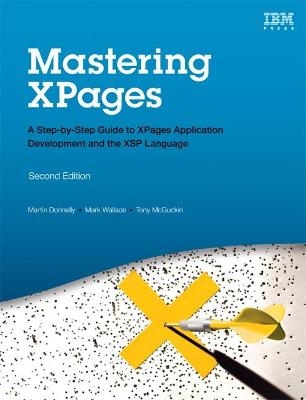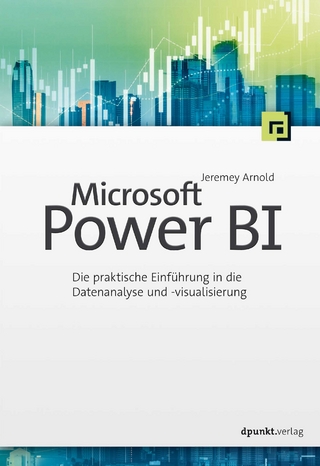
Mastering XPages
IBM Press (Verlag)
978-0-13-484547-0 (ISBN)
XPages instantly revolutionized Notes/Domino application development, and the newest versions deliver unprecedented performance and flexibility. Now, the popular insider's guide to XPages development has been updated and expanded to reflect all these improvements, through IBM Notes/Domino 9.0.1 and beyond.
Three key members of the IBM XPages team have brought together comprehensive knowledge for delivering outstanding solutions. They have added several hundred pages of new content, including four new chapters. Drawing on their unsurpassed experience, they present new tips, samples, and best practices reflecting the platform's growing maturity. Writing for both XPages newcomers and experts, they cover the entire project lifecycle, including problem debugging, performance optimization, and application scalability.
This second edition of Mastering XPages fully addresses enhancements to the XPages data sources for Domino views and documents; the latest XPages mobile library; the new Domino Designer Server-Side JavaScript debugger; and improvements to integrated technologies such as Dojo and CKEditor.
Nearly every chapter contains at least one downloadable sample application, offering extensive hands-on practice. This guide concludes with complete references to XSP tags, relevant Java/JavaScript classes, and XSP style classes.
Coverage includes
* Understanding XPages' development paradigm, tooling, runtime framework, and application architecture
* Configuring Domino Designer and integrating XPages Extension Library
* Constructing application logic and using data binding controls
* Reading/writing Notes documents: from use cases to design properties
* Using Views, including examples of accessing calendars via REST
* Making the most of Notes/Domino 9.0's new DataView control
* Coding: from the basics to fully customized behavior
* Advanced scripting: AJAX, Dojo, @Functions, managed beans, and more
* Extending the Rich Text Editor's functionality
* Building and consuming new controls with Extensibility APIs
* Taking web applications offline in the Notes client
* Building mobile apps: controls, design patterns, and best practices
* Debugging Server-Side JavaScript with Domino Designer 9.0
* Creating apps that look and work great–for local and global audiences
* Systematically optimizing performance and scalability
* Protecting data and users: leveraging Domino and Notes security models
The authors of this book have a number of things in common. All three hail from Ireland, work for the IBM Ireland software lab, and have made significant contributions to the development of XPages over the past number of years. Martin Donnelly is a software architect and technical lead for the Domino Designer and XPages teams in IBM Ireland. He has worked on all XPages releases to date and also on a precursor technology known as XFaces. Martin was also a development contributor to such products as the IBM Java Visual editor and IBM Rational Application Developer. In the 1990s while living and working in Massachusetts, Martin was a lead developer on Domino Designer; this has now gone full circle as he rejoined the Domino Designer team in 2013 to head up the 9.0.1 release. Martin lives in Cork with his wife Aileen, daughters Alison, Aisling, and Maeve, and retired greyhounds Evie and Chelsea. Outside of work his main leisure time pursuits are soccer, fishing, and gardening. Mark Wallace is a software architect in the IBM Ireland software lab. In the past, he worked on the XFaces runtime, which was developed for Lotus Component Designer and subsequently evolved into the XPages runtime. He has a keen interest in programming models and improving developer productivity. Mark has worked in Lotus and IBM for more than 17 years on various products, and he is currently leading the Social Business Toolkit open source project. Mark lives in Dublin with his wife and two children and spends as much time as possible in the Ireland’s sunny south east enjoying fishing and kayaking with his family. Tony McGuckin is a senior software engineer in the IBM Ireland software lab. Having studied software engineering at the University of Ulster, he began his career with IBM in 2006 and joined the XPages core runtime team shortly thereafter. When not directly contributing to the core runtime, Tony is busy with software research and development for the next generation of application development tooling, most recently focusing on mobile and responsive design. Tony also spends a lot of time directly engaging with IBM customers as an XPages consultant, where he shows his flair for UI development and his deep understanding of application performance. Tony enjoys spending time with his wife and daughter, and getting out into the great outdoors for hill walking and the occasional chance to do some hunting in the surrounding hillsides of his native County Derry.
Foreword xxiii
Preface xxvii
PART I: GETTING STARTED WITH XPAGES
Chapter 1 An Introduction to XPages 3
XPages Fundamentals 3
Onward and Upward: A Path of Continuous Improvement 4
The XPages Development Paradigm 8
The More Things Change, the More Things Stay the Same 10
New Horizons 11
Conclusion 12
Chapter 2 Getting Everything You Need 13
Downloads, Versions, and Locations 13
Installing Domino Designer 14
Installing Client Fix Packs 14
Client Configuration 15
Quick Tour of Domino Designer 16
Domino Designer Home Page 17
Domino Designer Perspective 17
Creating a New Application 19
Creating an XPage 20
Previewing in the Notes Client 21
Previewing in a Web Browser 22
Adding a Control to an XPage 24
Working with the XPages Extension Library 26
Some Quick Notes on Extension Library Structure 30
Conclusion 32
Chapter 3 Building Your First XPages Application 33
Laying the Foundations 34
Forms and Views 36
Building an XPages View 41
Completing the CRUD 47
Conclusion 53
PART II: XPAGES DEVELOPMENT: FIRST PRINCIPLES
Chapter 4 Anatomy of an XPage 57
What Exactly Is an XPage? 58
Understanding XSP Tag Markup 59
Getting Started with XML 59
XPages XML Syntax 62
Simple Properties 63
Complex Properties 64
Complex Values 66
Computed Properties 67
Data Binding 72
XPages Tags 72
Data Sources 73
Domino Document 73
Domino View 74
Data Context 75
Controls 76
Editing Controls 77
Command Controls 82
Selection Controls 85
Display Controls 94
File-Handling Controls 95
Containers 98
Panel 98
Table 101
View 102
Data Table 105
Repeat 106
Include Page 109
Tabbed Panel 110
Section 111
XPage Resources 111
JavaScript Library 112
Style Sheet 114
Resource Bundle 115
Dojo Module and Dojo Module Path 116
Generic Head Resource 116
Metadata Resource 117
Converters 118
Validators 121
Simple Actions 128
Client-Side Scripting 134
HTML Tags 136
Extension Library 137
Dynamic Content 138
Change Dynamic Content Action 142
In Place Form 143
Dialog, Dialog Context, and Dialog Button Bar 147
Tooltip Dialog 150
JSON RPC Service (Remote Service) 154
Conclusion 156
Chapter 5 XPages and JavaServer Faces 157
What Is JavaServer Faces? 158
JSF Primer 159
How Does XPages Extend JSF? 166
XML-Based Presentation Tier 169
Request Processing Lifecycle 169
User Interface Component Model 170
Standard User-Interface Components 176
Value Binding and Method Binding Expression Evaluation 179
XPages Default Variables 182
Conclusion 186
Chapter 6 Building XPages Application Logic 187
Adding Application Logic 187
Using the xp:eventHandler Tag 190
Simple Actions 198
Change Document Mode 198
Confirm Action 199
Create Response Document 200
Delete Document 201
Delete Selected Documents 202
Execute Client Script 203
Execute Script 204
Modify Field 205
Open Page 205
Publish Component Property 207
Publish View Column 208
Save Data Sources 209
Save Document 211
Set Component Mode 213
Set Value 214
Action Group 215
Send Mail 217
Change Dynamic Content 219
Move to Application Page 220
Using JavaScript with XPages 220
Server-Side JavaScript 221
Client JavaScript 240
Conclusion 250
PART III: DATA BINDING
Chapter 7 Working with Domino Documents 253
Domino Document Data Source 254
Creating and Editing Documents 257
Controlling URL Parameter Usage 258
Creating Response Documents 258
Executing Form Logic 263
Managing Concurrent Document Updates 266
Multiple Document Data Sources 272
Document Data Source Events 274
webQuerySaveAgent 278
Common Data Source Properties 282
Miscellaneous Data Source Properties 282
Working with Domino Documents—Programmatically! 283
Simple Actions 283
JavaScript 284
Rich Documents 286
Conclusion 291
Chapter 8 Working with Domino Views 293
databaseName Property 295
View Data Source Filters 296
categoryFilter Property 297
Full Text Search Properties 299
parentId Property 304
ignoreRequestParams Property 305
keys, keysExactMatch Properties 306
Other View Content Modifiers 309
startKeys Property 310
expandLevel Property 310
A Page with Two Views 312
requestParamPrefix Property 313
When Is a View Not a View? 314
Go Fetch! Or Maybe Not 315
loaded, scope Properties 316
postOpenView, queryOpenView Properties 316
Caching View Data 318
Sorting Columns 323
Combining Searching and Sorting 323
Accessing Calendar Data 326
The XPages Calendar REST Service 327
The iNotes Calendar Control 330
Conclusion 336
Chapter 9 Beyond the View Basics 337
Pick a View Control, Any View Control 337
The View Control: Up Close and Personal 340
Column Data Like You’ve Never Seen Before 341
Simple View Panel Make Over 343
Working with Categories 357
View Properties and View Panel Properties 366
Data Table 370
Building a Mini Embedded Profile View Using a Data Table 376
Repeat Control 381
A Repeat Control Design Pattern 383
Nested Repeats 384
The Rich Get Richer 386
Data View 387
Configuring a Basic Data View Control 389
Using More Advanced Data View Control Features 392
Some Fun with the Pager 395
Conclusion 398
PART IV: PROGRAMMABILITY
Chapter 10 Custom Controls 401
Divide and Conquer 402
Getting Started with Custom Controls 403
Using Property Definitions 411
Property Tab 415
Validation Tab 417
Visible Tab 419
Property Definitions Summary 420
Using the compositeData Object 421
Send and You Shall Receive 427
Multiple Instances and Property Groups 430
Custom Control Design Patterns 432
Aggregate Container Pattern 432
Layout Container Pattern 433
Conclusion 441
Chapter 11 Advanced Scripting 443
Application Frameworks 443
AJAX and Partial Refresh 444
Partial Refresh: Out-of-the-Box Style! 445
Partial Refresh: Doing-It-My-Way Style! 453
Event Parameters 460
Dojo Integration 463
dojoTheme and dojoParseOnLoad Properties 463
dojoModule Resource 464
dojoType and dojoAttributes Properties 466
Integrating Dojo Widgets and Extending the Dojo Class Path 466
Working with Traditional Notes/Domino Building Blocks 478
Working with @Functions, @Commands, and Formula Language 479
Working with Agents, In-Memory Documents, and Profile Documents 482
Managed Beans 490
Fulfilling a Customer Requirement: A Practical Field Study 496
Comparing Apples with Apples! 497
Who, What, Where, and (More Important) How? 503
Conclusion 536
Chapter 12 XPages Extensibility 537
How to Create a New User Interface Control 538
Example Component 539
Let’s Get Started 540
Create the Initial Application 540
Add Package Explorer to the Domino Designer Perspective 541
Add a Java Source Code Folder 543
Building a Component 544
Create a UI Component Extension Class 545
Create Tag Specification (.xsp-config) for the UI Component Extension 547
Create a Renderer and Register It in the Application Configuration
(faces-config.xml) 551
Quick Test Application to Verify Everything Is OK So Far 554
Working with Component Properties 555
Component Properties and Attributes 555
Adding a Property to a Component 556
State Holder: Saving State Between Requests 556
Specifying Simple Properties 557
Inheriting xsp-config Properties 558
Create the Initial xsp-config Definitions 562
Create base.xsp-config 562
Create an Interface to Match the Group Property Definition in base.xsp-config 565
Revisit the Component Properties in Domino Designer 568
Specifying Complex Properties 568
Complete the xsp-config for the UISpinner Component 579
Complete the UI Component Extension, UISpinner 588
Complete the Renderer UISpinnerRenderer 591
Create a Sample Application Using the UISpinner Component 597
Take Your New UI Component Extension for a Test Drive 597
Create a Backing Bean 597
Register the Backing Bean 600
Create the Final Test Application 600
Nice Look and Feel 604
Test to Ensure That It All Works! 604
Where to Go from Here 605
XPages Extensibility API Developers Guide 605
XPages Extension Library 606
IBM developerWorks 606
Conclusion 606
Chapter 13 XPages in the Notes Client 607
Think Inside the Box 608
Getting Started with XPages in the Notes Client 610
3, 2, 1...Lift Off 612
Bookmarks 614
Working Offline 616
One of These Things Is Not Like the Other 619
Other Subtle Differences 621
Extended Client-Side JavaScript Commands 624
XPages: A Good Notes Citizen 632
Introducing enableModifiedFlag and disableModifiedFlag 634
Keeping Tabs on Your Client Apps 637
Notes Links Versus Domino Links 641
Some XPiNC Debugging Tips 645
Optimizing XPages for Notes 649
Single Copy XPages Design Meets Preload 652
XPages RunOnServer 657
XPages and Composite Applications 664
Making a Component of an XPages Application 664
Is Anyone Out There? Creating a Component that Listens to Your XPages Component 666
Assembling a Composite Application: Aggregating the XPages Discussion Component and Notes Google Widget 668
Hey, This Is a Two-Way Street. A Component May Receive and Publish Events 672
Further Adventures with Composite Applications 675
Chapter 14 XPages Mobile Application Development 677
Getting Started with Mobile Application Development 678
Safari Browser 680
Chrome Browser 681
Firefox Browser 682
User Agent Device Detection 682
Device Bean 683
Single Page Application Design Pattern 685
Mobile XPage Properties 686
Single Page Application Control (xe:singlePageApp) 687
Mobile Application Navigation 688
Navigator 690
Hierarchical Navigation 692
Context-Sensitive Navigation 694
Interacting with a Mobile Application 697
Orientation-Based Interaction 697
Touch-Based Interaction 701
Multitouch-Based Interaction 702
Mobile Themes 703
Data View 704
Outline 706
Form Table 706
Styling XPages Controls for Mobile Applications 707
Debugging Mobile XPages 710
Debugging XPages on iOS 711
Debugging XPages with Web Inspector Remote (aka weinre) 713
XPages Mobile Extensions 716
Infinite Scrolling 717
Single Page Application Wizard 718
Summary 724
Chapter 15 XPages Unplugged and Debugged 725
Debugging XPages Apps on the Server Side 726
Printing, Dumping, and Logging 726
try / catch / finally 729
Introducing the SSJS Debugger 735
Using the Java Debugger 748
Enabling XPages Java Logging 755
Debugging XPages Apps on the Client Side 759
CSJS Debuggers 760
Debugging Dojo 762
Conclusion 765
PART V: APPLICATION USER EXPERIENCE
Chapter 16 XPages Theming 769
It Used to Be Like That...But Not Anymore 769
Styling with Style 771
Setting the Style Property Manually 776
Understanding How the Style Property Is Used 777
Computing the Style Property 778
Styling with Class 779
Getting Something for Nothing 779
Understanding How the styleClass Property Is Used 785
Computing the styleClass Property 788
Working with Extended styleClass and style Properties 790
Theming on Steroids! 794
What Is a Theme? 794
What Can You Do with a Theme? 795
Understanding Theme Architecture and Inheritance 796
Working with a Theme 804
Theme Resources 814
Resource Paths 824
Theme Properties, themeId, Control Definitions, and Control Properties 832
Conclusion 848
Chapter 17 Application Layout 849
Divide and Conquer 849
Application Layout: One Easy Way 850
Application Layout: Customizing the Content Area 865
Conclusion 870
Chapter 18 Internationalization 871
Using Localization Options 872
Localization with Resource Bundle Files 873
Setting Localization Options 874
Testing a Localized Application 877
Working with Translators 878
Merging XPage Changes 881
Gotchas! 883
Localizing Computed Expressions and JavaScript 885
Adding a Resource Bundle 887
Localizing Computed Expressions 889
Localizing Client-Side JavaScript 889
Localizing Script Libraries 890
Server-Side Script Libraries 890
Client-Side Script Libraries 891
International Enablement 893
Locales in XPages 894
Deprecated Locale Codes 898
Localizing Computed Fields 900
Conclusion 901
PART VI: PERFORMANCE, SCALABILITY, AND SECURITY
Chapter 19 A First Look at Performance and Scalability 905
Golden Rules 906
Understanding the XPages Request Processing Lifecycle 908
GET-Based Requests and the XPages Request Processing Lifecycle 909
POST-Based Requests and the XPages Request Processing Lifecycle 910
Reducing CPU Utilization 912
GET-Based Versus POST-Based Requests 912
Partial Refresh 917
Partial Execution Mode 919
Reducing Memory Utilization 923
HTTPJVMMaxHeapSize and HTTPJVMMaxHeapSizeSet Parameters 924
xsp.persistence.* Properties 925
dataCache Property 926
Conclusion 928
Chapter 20 Advanced Performance Topics 931
Making Efficient XPages Requests 931
Profiling XPages Applications 932
Introspecting XPages Requests Using a PhaseListener 949
The Myths and Realities of the Rendered and Loaded Properties 964
Using Partial Refresh, Partial Execution, and Dynamic Content 981
Making Scalable XPages Requests 1004
Understanding the XPages Memory Model 1005
Analyzing XPages Memory Usage 1008
Establishing the Optimal Scalability Configuration 1020
Conclusion 1034
Chapter 21 Security 1035
Notes/Domino Security and XPages 1035
Server Layer of Security 1036
Application Layer of Security 1037
Design Element Layer of Security 1039
Document Layer of Security 1046
Workstation ECL Layer of Security 1048
Useful Resources 1049
Now Get Started 1049
Creating the Initial Application 1049
Implementing ACLs 1051
Sign the XPages with Your Signature 1052
Programmability Restrictions 1053
Sign or Run Unrestricted Methods and Operations 1054
Sign Agents to Run on Behalf of Someone Else 1055
Sign Agents or XPages to Run on Behalf of the Invoker 1055
Sign Script Libraries to Run on Behalf of Someone Else 1055
Restricted Operation 1056
XPages Security Checking 1057
NSF ClassLoader Bridge 1058
XPages Security in the Notes Client 1058
Execution Control List (ECL) 1059
Active Content Filtering 1062
Public Access 1065
Setting Public Access for XPages 1065
Checking for Public Access in XPages 1066
SessionAsSigner 1067
Enabling Extended Java Code with the java.policy File 1069
Conclusion 1071
PART VII: APPENDIXES
Appendix A XSP Programming Reference 1075
XSP Tag Reference 1075
XSP Java Classes 1076
Notes/Domino Java API Classes 1078
XSP JavaScript Pseudo Classes 1078
Appendix B XSP Style Class Reference 1081
XSP CSS Files 1081
XSP Style Classes 1082
IBM OneUI Themes and Documentation 1086
Appendix C Useful XPages Sites on the Net 1087
Index 1089
| Erscheinungsdatum | 07.07.2017 |
|---|---|
| Reihe/Serie | IBM Press |
| Verlagsort | Armonk |
| Sprache | englisch |
| Maße | 180 x 231 mm |
| Gewicht | 1850 g |
| Themenwelt | Mathematik / Informatik ► Informatik ► Office Programme |
| Mathematik / Informatik ► Informatik ► Web / Internet | |
| ISBN-10 | 0-13-484547-1 / 0134845471 |
| ISBN-13 | 978-0-13-484547-0 / 9780134845470 |
| Zustand | Neuware |
| Haben Sie eine Frage zum Produkt? |
aus dem Bereich


